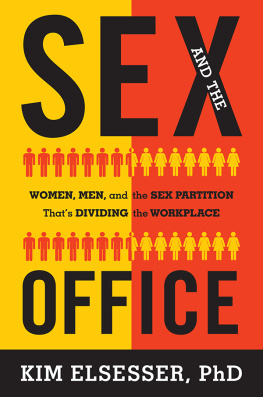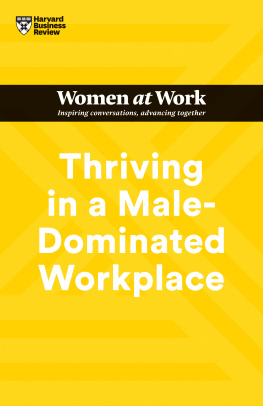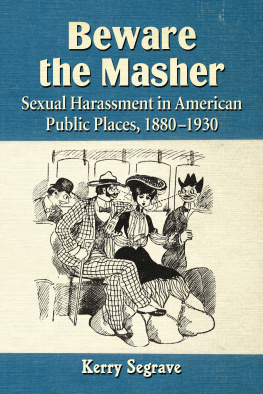Sex and the Office
Sex and the Office
Women, Men, and the Sex Partition Thats Dividing the Workplace
Kim Elsesser
TAYLOR TRADE PUBLISHING
Lanham Boulder New York London
Published by Taylor Trade Publishing
An imprint of The Rowman & Littlefield Publishing Group, Inc.
4501 Forbes Boulevard, Suite 200, Lanham, Maryland 20706
www.rowman.com
Unit A, Whitacre Mews, 26-34 Stannary Street, London SE11 4AB, United Kingdom
Distributed by NATIONAL BOOK NETWORK
Copyright 2015 by Kim Elsesser
All rights reserved . No part of this book may be reproduced in any form or by any electronic or mechanical means, including information storage and retrieval systems, without written permission from the publisher, except by a reviewer who may quote passages in a review.
British Library Cataloguing in Publication Information Available
Library of Congress Cataloging-in-Publication Data
Elsesser, Kim.
Sex and the office : women, men, and the sex partition thats dividing the workplace / Kim Elsesser.
pages cm
Summary: In Sex and the Office, Kim Elsesser delves into how issues as varied as sexual harassment, workplace romance, spousal jealousy, and communication styles create barriers between men and women at work. These invisible barriers, which Elsesser labels the sex partition, tend to have the greatest impact on the careers of women, because men typically still dominate senior management, and connections with senior managers are essential for career advancement. Elsesser describes how senior male employees prefer to stick with other men, especially when it comes to dinners, drinks, late-night meetings, or business trips. When its time for promotions or pay raises, these same executives are more likely to show preference to the employees with whom they feel most comfortableother men. Elsesser doesnt blame men for the sex partition; instead, she describes how some common organizational practices create barriers between the sexes. She offers practical advice on how to break down the sex partition and reveals the best strategies for networking with the opposite sex. Sex and the Office is sure to spark new dialogue on the sources of the gender gap at work. Provided by publisher.
Includes bibliographical references and index.
ISBN 978-1-4930-0794-3 (hardback) ISBN 978-1-63076-121-9 (electronic) 1. WomenEmployment. 2. Sex role in the work environment. 3. Sexual harassment. 4. Interpersonal relations. 5. Business networks. 6. Career development. I. Title.
HD6060.E44 2015
302.3'5dc23
2015006762
 The paper used in this publication meets the minimum requirements of American National Standard for Information SciencesPermanence of Paper for Printed Library Materials, ANSI/NISO Z39.48-1992.
The paper used in this publication meets the minimum requirements of American National Standard for Information SciencesPermanence of Paper for Printed Library Materials, ANSI/NISO Z39.48-1992.
Printed in the United States of America
For Bradley
Preface
W hile attending college at Vassar, I was inspired by the tradition of empowering women and education in a female-dominated environment. After Vassar, I headed to graduate school at MIT to study business and operations research (a field that applies advanced math to study decisions made by organizations). When I started at MIT, I recall being told that only 19 percent of the graduate students were women.
Coming from Vassar, MIT offered quite a culture shock. Rumor had it that a few MIT professors still thought that admitting women to MIT was a mistake, and that female students were too much of a distraction for the male students. I didnt think there could be a less female-friendly environment than MIT, until I landed a job on the trading floor at Morgan Stanley. There, a senior trader and I launched a quantitative proprietary trading group, which became one of the most successful in the companys history.
Female traders were almost nonexistent at the time. There were plenty of women on the trading floor, but they were mostly employed as assistants to the traders and salespeople. Occasionally mistaken for an assistant, I was asked to get coffee and order lunch by those who didnt know my role, and my male subordinates were occasionally forced to explain that I was their boss and not their assistant.
During my tenure in trading, I strived to understand why there were so few women at senior levels of management. After all, it wasnt so bad on the trading floor. Thats not to say I completely fit in either. For example, my male anatomy, or lack thereof, came up in conversation with surprising frequency. Did I have the balls to do that trade? Was my dick big enough? Or, more frequently, I needed to get some balls. It didnt take long to come up with snappy answers to these comments, and soon I was one of the boys. Or was I?
Certainly, within my small proprietary trading group, everyone established close friendships with one another. We worked long hours together and often socialized after work and on weekends. My manager and I spent an inordinate amount of time together. Building a trading group from scratch had innumerable challenges, and we spent a lot of time discussing each one. There were insinuations that we were more than friendswe werent.
Although everyone within our trading group became friends, when it came to those coworkers outside our small group, friendship was much tougher. Sometimes it seemed like senior management avoided contact with me and that I made them uncomfortable. But that was no problem; Morgan Stanley sponsored many outings where I could get to know senior management and show them how fabulous I was.
For example, the equity division at Morgan Stanley had its annual officers meetings at beautiful resorts, and these meetings provided long afternoon breaks. It would be easy to befriend senior management by the pool in the afternoon. It turns out the afternoon break was primarily for golfing. Although I had taken a golf class at Vassar, I certainly wasnt ready to go tee-to-tee with male managers who practiced every weekend. I went jogging alone while my male colleagues enjoyed an afternoon of golf together. I promised myself I would work on my swing.
Even if my golf swing wasnt up to par, there would be other opportunities to socialize with management. At one outing, as evening fell, I headed out to see what others were up to. Where are you going? I asked my colleague who was heading out of the hotel bar. It was time for the poker game, I was told.
Youre welcome to join us, he added as he left the bar. Join them? I didnt know how to play poker, and with the stakes they played for, I certainly wasnt going to ask for lessons. Instead, I headed to bed early.
Its not that I was explicitly excluded from these events. I certainly could have played poker or shot a round of golf, but I couldnt get much further from my comfort zone. Meanwhile, my male colleagues were chalking up lots of face time with the big shots in the department. I was determined not to let any more opportunities pass by. Not long thereafter, another opportunity knocked.
The head of my division was taking some managers out for drinks. Do you want to join us? they asked. Drinking? Yes, I could do that. There was one catch, I was told. The section of the club where we were headed was for men only. If I could get in, then wed have our own private room to shoot pool.
I had long blonde hair, and like to think I didnt look much like a man, but I wasnt going to let this opportunity get away. No problem, I could do this. A coworker lent me a long trench coat, and another lent me a hat. I tucked my blonde locks into the hat, and felt pretty ridiculous. Is this how I was going to impress management?
At the club, words and a tip were exchanged with the doorman, and soon we were in a private room with a pool table. Now that I was inside, I merely had to demonstrate my brilliance while playing pool. I hadnt shot pool since high school, but I reasoned I could just apply my knowledge of physics. Angle of incidence equals angle of reflectionhow hard could it be? I held my own.
Next page








 The paper used in this publication meets the minimum requirements of American National Standard for Information SciencesPermanence of Paper for Printed Library Materials, ANSI/NISO Z39.48-1992.
The paper used in this publication meets the minimum requirements of American National Standard for Information SciencesPermanence of Paper for Printed Library Materials, ANSI/NISO Z39.48-1992.